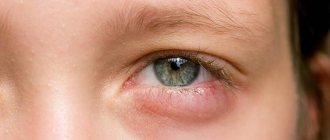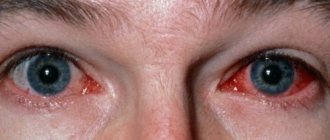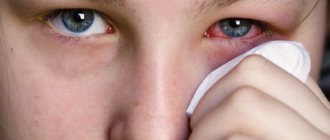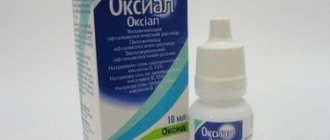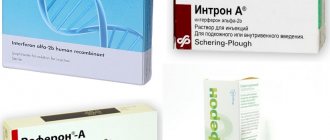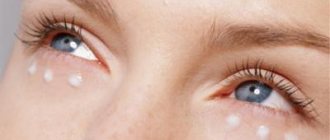Description of the medication
This is not the only name of the drug, since in medicine there is another designation for eye drops - Albucid. This is a pharmaceutical solution whose active ingredient is sulfacetamide. The drug is absolutely safe for the eyes due to its water base with a low alkalinity reaction. Eye drops also have an international name - Sulfacetamidum.
Sulfacyl
Due to its pronounced antimicrobial properties, the drug is actively used in ophthalmic practice. The main difference between this antiseptic and antibiotics is the nature of its origin, so Albucid can also be prescribed to children.
Albucid
special instructions
Before using this product, the cap on the bottle should not be screwed on tightly. As for the first use, before such a procedure the cap must be screwed all the way. In this case, the spike, which is located on its inner side, should pierce a hole in the membrane. Before direct use, it is recommended to hold the bottle of medicinal liquid in your hand so that it warms up to the temperature of the human body. After this, the cap must be unscrewed, removed, and then lightly pressed on the soft body and dripped the solution into the eyes. At the end of the treatment procedure, the bottle of medicine should be tightly closed.
Difference in drugs
Pharmacy chains may sell this drug under different names. In this regard, many consumers have a logical question about what is the difference between Sulfacyl Sodium medications and Sulfacyl Sodium-DIA. Experts answer it unequivocally. These drugs are no different from each other (neither in principle of action nor in composition). Both medications can be used for conjunctivitis, eye trauma, blenorrhea and other abnormalities. The only difference between them is that they have different manufacturers. In particular, the drug “Sodium Sulfacyl-DIA” is manufactured, which explains its name.
Sulfacyl Sodium Drops
Ophthalmology today uses a wide range of drugs that can effectively cope with infections that affect the human eye. Doctors often prescribe Sulfacyl sodium drops (Sulfacyl soluble), which are used to treat infectious eye diseases caused by pathogenic microorganisms. Some patients are interested in the difference between Albucid and Sulfacyl sodium: this is one medicine, the first name is considered outdated. It is necessary to strictly adhere to the instructions for use of the ophthalmic drug.
Compound
Sodium sulfacyl is a sterile aqueous solution of the main active ingredient. Eye drops are a weak-smelling, transparent liquid of uniform consistency. The main element of the drug is sulfacetamide. The amount of this component depends on the age category of the patient. Children's drops contain 0.2 grams per ml of solution; adult products contain 0.3 ml per identical amount of liquid. Additional components of the drug for the eyes:
- purified water;
- sodium sulfidetrioxosulfate;
- hydrochloric acid solution.
Release form
Anti-infective eye drops are produced in polyethylene bottles of 5 and 10 ml. They are hermetically sealed with special dropper caps and lids. All bottles are placed in separate cardboard boxes, each containing instructions for using sulfacetamide. You can also find medicine sets of 50 bottles per box.
Pharmacodynamics and pharmacokinetics
The drug belongs to sulfonamide antimicrobial agents with broad action. This medication also has a bacteriostatic effect. Drops are no worse than antibiotics in helping to fight gram-negative and gram-positive bacteria (gonococci, streptococci, E. coli), actinomycetes, and chlamydia. When the medicine is used topically, the active substance enters the fluids and tissues of the eyes. Sulfacetamide can also penetrate through the conjunctiva affected by a bacterial infection into the systemic circulation.
Indications for use
The main indications for the use of antibacterial eye drops are the following pathological processes:
- Treatment of conjunctivitis - inflammation of the outer layer of the eye.
- Keratitis is a lesion of the cornea of the eye.
- Treatment of blenorrhea - an inflammatory process of the eyes caused by gonococcus. Drops are used not only for therapy, but also for the prevention of blenorrhea in newborns.
- Blepharitis is a separate group of eye pathologies in which chronic inflammation of the eyelid margins is observed.
- Purulent ulcers of the cornea. The product effectively blocks suppuration and accelerates the healing process of the cornea of the eye.
- Prevention of purulent inflammation caused by foreign objects, dust, sand, etc. getting into the eyes.
- Preventive measures prescribed by a doctor after eye surgery. The drops have a bacteriostatic effect and help prevent the development of infection.
Contraindications
Like any other medical drug, Sulfacyl has certain prohibitions on its use. The main contraindication is individual hypersensitivity to the drug or its individual components. Ophthalmologists do not recommend using drops when wearing contact lenses. If a person wants to use a therapeutic agent, the lenses must first be removed so that they do not become cloudy. You can put them back on half an hour after instilling eye drops.
pharmachologic effect
Sulfacetamide is a derivative of the antibiotic sulfanilamide, which has a broad spectrum of antimicrobial activity. It has a static effect on bacteria, suppressing their reproduction due to inhibition of enzymes involved in the metabolic processes of vital substances.
Albucid is active against bacteria such as Escherichia coli, chlamydia, streptococci, and staphylococci.
When applied topically, it penetrates well into the tissues and fluids of the eyeball. It is slightly absorbed through the inflamed conjunctiva into the systemic circulation.
Which is better Sulfacyl sodium or Albucid
Patients often think about this, especially young mothers, who are faced with the choice of using Albucid or Sulfacil to treat their newborn children. Experts believe that both of these drugs are beneficial and help quickly get rid of infection and inflammation.
Both drugs are available in the form of a solution intended for eye drops. They negatively affect pathogenic organisms, preventing them from multiplying and spreading throughout the body.
Each patient decides which drug to choose independently. If in doubt, it is better to trust your doctor.
Content
- 1 Pharmacological action
- 2 Dosage form: eye drops, ointment for external use 2.1 Pharmacokinetics
- 2.2 Indications
- 2.3 Contraindications
- 2.4 Dosage regimen
- 2.5 Side effects
- 2.6 Special instructions
- 2.7 Interaction
- 3.1 Indications
Can I put it in my nose?
The instructions for use of the drops contain instructions that Albucid is used to treat infectious diseases of the organs of vision.
However, in some cases, specialists prescribe a drug for a runny nose caused by a bacterial infection. Its difference from ordinary rhinitis lies in the greenish-yellow thick discharge, which cannot be gotten rid of with the usual vasoconstrictors.
Most often, the drug is prescribed for the treatment of sinusitis as part of complex therapy, rhinitis of unknown origin, and also for the prevention of adenoiditis.
If the causative agent of the disease is resistant to the active component, the drug may become ineffective. In addition, a severe bacterial infection most often cannot be cured with this medication.
Thus, Sulfacyl sodium has the following advantages:
- affordable price. Similar medications that include an antibiotic are much more expensive;
- absence of dependence and addiction. Almost all drugs that constrict blood vessels are addictive, so they are not recommended for use for more than 5-7 days;
- Local use of the drug prevents sulfacetamide from entering the circulatory system, so negative reactions occur in rare cases.
Many experts prefer Albucid as the most accessible and inexpensive remedy available in any home pharmacy.
Analogs
Perhaps the main analogue of Albucid eye drops is Floxal drops. They have a similar composition with a high content of sulfacetamyl and are used to combat infectious eye diseases. It is worth looking at the instructions for using Floxal eye drops.
Also among Albucid analogues the following drops are often called:
- Oftaquix;
- Normax eye drops;
- Tobrex;
- Levomycytin
- Combined duo.
It is not recommended to use analogue drops without consulting a doctor. The fact is that each such remedy has individual contraindications and a unique composition that can cause an unpredictable reaction in the body.
For example, Levomycytin is not recommended for the treatment of newborns, and for children over three years of age they are prescribed only after a thorough examination and study of the medical record. It is important to read the instructions for Tobrex eye drops and the instructions for using Combinil Duo eye drops.
Phloxal
An assistant for the treatment of allergic conjunctivitis - Allergodil eye drops.
Undesirable manifestations
In most patients, the use of eye drops does not cause any undesirable effects if you strictly follow all the doctor’s recommendations and do not exceed the prescribed dosage. In cases where the recommended amount of the drug is exceeded, the following symptoms may occur:
- burning;
- itching;
- tearfulness;
- swelling;
- redness.
In rare cases, allergic reactions may occur, manifested in the form of itching and redness of the skin, sneezing. After a short period of time after instillation of the eyes, you can notice a whitish coating on the eyelids; it appears due to the spillage of excess solution; it does not pose any threat to the patient.
All undesirable manifestations should subside within one hour after administration of the drug to the eyes; if they occur longer, then it is necessary to urgently seek help from an ophthalmologist.
Contraindications
Albucid is contraindicated if you have a history of allergic reactions to sulfacetamide or other drugs of the sulfaminamide group.
You may find the article from the same section, Systane eye drops, no less useful.
The causes of exophthalmos, as well as the treatment and prevention of this disease are covered in this publication.
The effect of the drug on the children's body
Pediatricians prescribe sodium sulfacil to be instilled into a child’s nose from the first days of life, explaining that it has few side effects. At the same time, the product has a good drying effect and kills bacteria. Small children do not know how to blow their nose, and thanks to albucid, inflammation of the sinuses becomes less, and the mucus comes out easier. It is easy to remove with an aspirator.
Such drops do not have the vasoconstrictor effect that many modern drugs for the treatment of the common cold have. This action is undesirable in principle and is addictive, especially for children.
Despite the fact that the drug is safe, it should not be used in newborns without consulting a pediatrician. Albucid has a powerful antimicrobial effect, so in some cases it can harm the baby.
Indications for use
The drug is widely used for the treatment of purulent, inflammatory diseases that arise as a result of the activity of pathogens that are extremely sensitive to Sulfacetamide.
Typically, drops are prescribed in the following cases:
- for purulent conjunctivitis and blepharitis;
- when purulent ulcers are detected on the cornea of the eye;
- when the eye canal is damaged by various bacteria;
- for the prevention of gonococcal conjunctivitis in newborns.
Despite the fact that the product has a safe composition for both children and adults, it should be used to treat newborns only after consultation with a pediatrician. The doctor must prescribe a dosage appropriate for the child’s age.
Sulfacetamide, which is the main ingredient in these drops, has a bacteriostatic effect. Sodium sulfacyl in drops easily penetrates the tissues of the eye (or nose - drops are often prescribed to treat runny nose in children) and stops the proliferation of pathogens. As a result, the patient begins to feel well within 3-5 days after using the medication.
Blepharitis
Treatment of bacterial conjunctivitis – Azidrop eye drops. See instructions for Azopt eye drops here.
Sulfatsil Belmed
Sulfacil Belmed - eye drops consisting of the following components: specially purified water, sodium sulfacetamide and sodium thiosulfate.
The use of the drug is indicated in cases of detection of one of the following pathological processes:
- gonorrheal eye diseases;
- conjunctivitis;
- purulent ulcers of the cornea;
- prevention of blenorrhea;
- blepharitis;
- viral eye infection;
- fungal infection of the eyes.
Each drug, in addition to its indications for use, also has contraindications. Among them, individual intolerance to any of the components of the composition should be specially noted.
In addition, sulfacyl Belmed is not recommended for use during pregnancy and breastfeeding unless indicated by the attending physician.
Methods of using this drug and its dosage depend on the patient’s problem:
- in cases of blepharitis, treatment is carried out from 6 to 8 times a day, when the patient’s condition improves, the frequency of use is reduced to 3-4 times;
- in the presence of conjunctivitis, the drug is instilled every 60 minutes, excluding sleep time, for 2 days, after which it is reduced to 6 times a day;
- Gonorrheal eye diseases are treated on a daily basis for 5-6 weeks, instilling 2 drops into each conjunctival sac 6 times a day.
The duration of the therapeutic course should be regulated only by a qualified specialist.
With frequent use of Belmed sulfacyl, the patient may experience overdose symptoms, which include:
- redness of the eyes;
- itching;
- swelling of the upper and lower eyelids;
- irritation of the mucous membrane.
If at least one of the above factors is detected, it is necessary to switch either to a drug with a lower concentration of the active substance, or to completely stop using it and seek help from specialists.
Permitted and prohibited drops during breastfeeding
A nursing mother's first aid kit is different from that of other family members. Drugs suitable for others may be prohibited for breastfeeding.
Their use affects the health and condition of the child.
Therefore, nursing mothers should take a more responsible approach to the treatment of eye diseases, using only approved drugs.
Vigamox
Pregnancy and breastfeeding (BF) are contraindications to the use of the drug. No research has been conducted on women in this category, so doctors prescribe medications, but in lower dosages and under strict control.
It is recommended to use the drug after feeding and after an hour to express milk (GM) to protect the baby. Improvement occurs within 5 days from the start of use. After the signs disappear, Vigamox is instilled for another 2-3 days to consolidate the result.
First, let's look at the drops allowed during lactation.
Albucid
The active substance takes part in the metabolic processes of pathogenic microorganisms. Interferes with the absorption of components necessary for growth. Albucid destroys bacterial walls. Albucid is allowed to be used by children from birth, which means that use during lactation is also possible, without stopping breastfeeding (EB).
The dosage is determined depending on the severity of the inflammatory process.
Visine Pure Tear
The instructions indicate that the medicine can be used during pregnancy and pregnancy. Visine is prescribed for allergic reactions, eye irritation from contact lenses or cosmetics.
For breastfeeding, drops are contraindicated if the mother has an allergic reaction to the medication or another contraindication.
Visin Classic and Allergy are also approved for use, but only in cases where the possible benefit outweighs the potential risk to the child and fetus.
Tobrex
An antibiotic with a broad spectrum of activity is allowed for hepatitis B. Tobrex stops the development of bacteria. The effect persists only with systematic instillation of the drug.
It is recommended to use Tobrex for 1 week, 1 dose up to 5 times a day. You cannot bury it for more than 7 days. Bacteria become resistant to the action of the active component.
Oftalmoferon
This is a local immunomodulator. Oftalmoferon is recommended for use for any eye diseases that are viral in nature. However, patients should be aware that the medicine has unproven effectiveness.
The decision to prescribe the drug is made by the doctor, since according to the instructions it is prohibited during breastfeeding and pregnancy. Ophthalmologists prescribe Oftalmoferon, but in a smaller dosage.
Aktipol
It has antiviral, immunomodulatory and antioxidant effects. If conjunctivitis in a nursing mother occurs due to a cold or other reason, the use of the medication is permitted.
To combat the disease, Actipol is instilled up to 8 times during the day, the dosage per application is 2 drops.
Vitabact
The product has a wide spectrum of action. Is an antibiotic. Vitabact does not affect GM. The drug is prescribed without fear for the treatment of eye diseases in nursing women.
Hilo chest of drawers
Moisturizing solution for eyes in the form of drops. The only contraindication for use is hypersensitivity to the components.
Hilo-chest should be used with caution during breastfeeding, only after consulting an ophthalmologist. Usually 1-2 drops are instilled. into the conjunctival cavity up to 3 times a day.
Ciprofloxacin
Ciprofloxacin does not act on viruses and is antibacterial. Prescribed to prevent the growth of bacteria that attack a dry, damaged eye.
Betadrine
A combined drug belonging to the group of antihistamines. Almost all anti-allergy medications are prohibited from the 2nd trimester and during lactation. Among the antihistamines, there are no absolutely safe ones, even those approved for hepatitis B.
Betadrine should only be used when absolutely necessary. In this case, it is advisable to stop breastfeeding, since there is no data on penetration into milk.
Fenistil
Antiallergic drops are prescribed to children after 1 month of life, which means that Fenistil can be instilled during lactation. The medication is prescribed to reduce itching and redness.
Fenistil does not treat the cause, it only relieves the symptoms caused by allergies. It is considered the safest and most effective during lactation and pregnancy.
Use 20–40 drops at least 3 times a day. May cause drowsiness and apathy. The daily dose can be divided into 2 doses.
Diclofenac
The medicine in drops is considered safe for nursing mothers, since the active ingredient practically does not penetrate into the GM. The active substance disintegrates quickly.
Even if it passes into breast milk, Diclofenac does not pose a danger to the baby; it penetrates in very small quantities. The maximum concentration in the blood is reached after an hour.
If a woman is afraid of getting into the GM, you can calculate the periods of feeding and express an hour after instilling Diclofenac.
Zyrtec
The medicine has an antihistamine effect. It is prescribed to children from 6 months of age; therefore, it is allowed to be used during breastfeeding.
The product is sold without a doctor's prescription. May cause diarrhea, cephalalgia and menstrual irregularities.
Sulfacyl sodium
Antibacterial medication, containing sulfacetamide, is allowed to be instilled into the eyes during breastfeeding. Prescribed for the treatment of conjunctivitis during lactation, for blepharitis and purulent ulcers.
Sulfacyl sodium is contraindicated for use in case of hypersensitivity to the active components or excipients. Causes itching, redness and swelling.
Sulfacyl sodium is used for breastfeeding up to 6 times a day. Dosage - 2-3 drops. Instill medications into the lower conjunctival sac after performing hygiene procedures.
List of prohibited drops during breastfeeding
Most medications are prohibited for use in EV. Ophthalmologists reduce the dosage or frequency of use if it is not possible to use approved drugs for various reasons.
There is a list of medications that should never be used during lactation. The active components with GM penetrate into the child and, with prolonged exposure, cause serious systemic reactions in children. Such drugs include:
- Levomycetin;
- Tsipromed;
- Signicef.
All ophthalmic medications belonging to the group of fluoroquinolones are prohibited for hepatitis B.
Some antihistamines are used once a day. These are usually strong medications and are therefore prohibited during breastfeeding.
However, if other drugs cannot be used due to an allergic reaction or due to contraindications, such medications can be used. But you will have to skip 1 feeding and express milk when the concentration of the product reaches its maximum level.
When to stop breastfeeding
When taking medications, you should not interrupt breastfeeding. Medicines prescribed by doctors can be instilled during breastfeeding. Only when several factors coincide is the GW interrupted:
- the child has a weak body and is less than 3 months old;
- there is a strict contraindication to the use of the product;
- The doctor insists on temporarily stopping natural feeding and switching the baby to formula.
To ensure that medications used to treat eye diseases do not cause serious problems for mother and baby, they should be used as recommended by a doctor, without changing the dosage or frequency of use for a speedy recovery.
It is necessary to use eye drops according to the instructions for use and always consult an ophthalmologist, especially if adverse reactions occur.
Was the article helpful?
Source: https://proglazki.ru/kapli-dlya-glaz/razreshennye-i-zapreshhennye-kapli-pri-grudnom-vskarmlivanii/
Instructions
Before opening the bottle, wash your hands thoroughly. Before you drip sodium sulfacyl into your nose, you need to hold the bottle in your hands and warm it to body temperature. You must first rinse your nose with Aqua Maris or a water-salt solution.
A 10% or 20% solution in an amount of 2-3 drops is instilled 3-4 times a day for a week, subject to positive dynamics. If after this period there is no improvement, sodium sulfacyl must be changed to another antibacterial agent.
The short-term burning sensation goes away on its own and does not require any special measures. This is not a sign of adverse effects on the nasal mucosa.
After the procedure, you must close the lid tightly. If the seal is lost, the drug is effective for 7 days, and then loses its properties. The shelf life of sulfacyl does not exceed 2 years if the tube is not opened. It is advisable to store the drug in a place inaccessible to sunlight and children, ideally in the refrigerator.
Instructions for use
The use of Albucid eye drops does not imply any specific difficulties. How should you instill such a product:
- Before using the medication, you should wash your eyes and hands, as this reduces the risk of infection.
- Next, you need to pull the lower eyelid down with your left hand, and take a bottle of drops in your right hand.
- Drops should be used up to six times a day during the acute stage of the disease (2-3 drops).
- If there are no acute symptoms and only slight discomfort, the product should be used up to four times daily.
- The maximum period of use is 6-8 days. In especially severe cases, this period can be increased to 10.
- After instillation, the patient should close his eyes so that the product does not spread.
A 30% Albucid solution should be used to treat adults, but a composition with a lower concentration of 20% is suitable for treating children.
Drug interactions
Find out what treatment for allergies on the eyelids of an adult is correct by following the link.
Mode of application
When treating certain pathologies in adults, doctors, as a rule, prescribe a 30% solution of the drug. You need to drop 1-2 drops of the drug into each eye. Depending on the severity of the pathology, the number of procedures may vary (from 3 to 6 instillations). If the symptoms of the disease are accompanied by more pronounced symptoms, the doctor may decide to increase the frequency of use of sodium sulfacyl. The same applies to the duration of the therapeutic course, which is determined individually.
Features of application
There are a few guidelines to follow when using sulfacetamide eye drops:
- If the patient wears contact lenses, they must be removed before instillation. Approximately 15 minutes after the procedure, the lenses can be put back on. Ignoring this rule may lead to a decrease in the effectiveness of the medicine or damage to contact lenses (especially if they are soft);
- It is strictly not recommended to combine the use of sodium sulfacyl with other drugs that contain silver salt;
Sulfacyl sodium drops for eyes
- a reduction in the bacteriostatic effect of the drug is possible when using sodium sulfacyl together with Dicaine or Novocaine. Therefore, before starting treatment, you need to agree on the entire list of drugs used with your doctor;
- The bottle of medicine must be warmed to body temperature before use. To do this, just hold it in warm palms for several minutes.
Instilling eye drops
Sodium sulfacyl is available without a doctor's prescription, but this does not mean that you can use it independently and without the knowledge of an ophthalmologist. First, the patient must undergo all diagnostic tests, and only then, based on the results obtained, the attending physician will be able to make a decision on prescribing the drug.
Sulfacyl sodium Solopharm, DIA
At the moment, when a patient contacts a pharmacy with a request to sell him sodium sulfacyl, the pharmacist asks the question: which one?
The thing is that there are several manufacturers of this drug. And many patients are at a loss as to which drug is best.
In addition to ordinary albucid, which can be produced by Moscow or Kurgan, there are sodium sulfacyl DIA and Solopharm.
Additional occurrences in the name indicate not only the brand and city of the manufacturer. There are some differences in these medicines.
Manufacturers make allowances for the fact that drugs of this class should not be used by children under two months of age, as well as by pregnant and nursing mothers.
Although the medicine is packaged in larger plastic containers than regular albucide, its shelf life after opening the package also does not exceed 30 calendar days.
In addition, it should be remembered that sodium sulfacyl DIA is available only in a 10 or 20% solution, which can significantly affect the treatment process for an adult, especially if up to this point he has always used a 30% solution.
In this case, of course, there is no need to talk about the effectiveness of the drug; the significance of the course of treatment will depend on the number of times the drug is used
The doctor must focus the patient’s attention on the percentage of the substance in the prescribed drug
